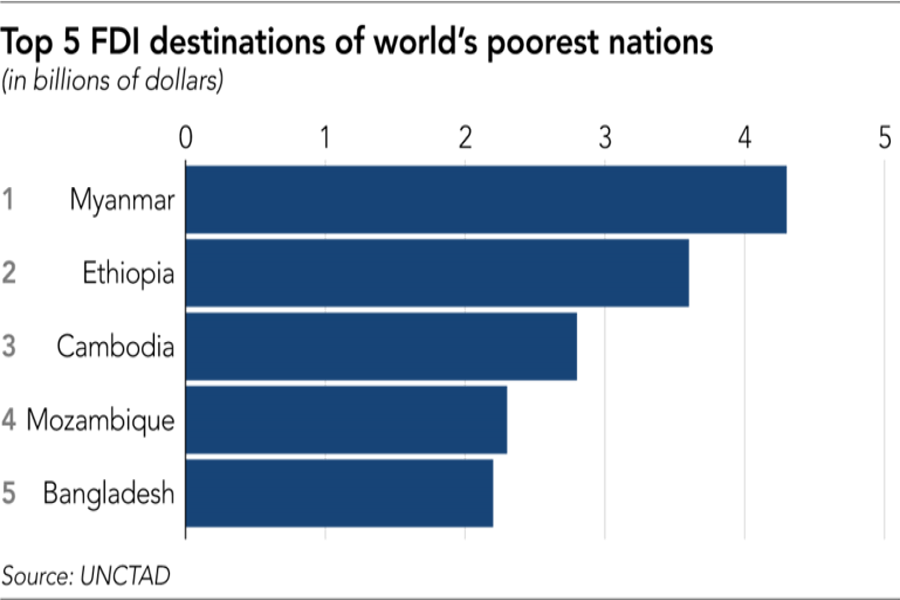JAKARTA : Myanmar attracted the most foreign direct investment of any of the world's so-called "least developed countries" in 2017, even as the nation's reputation plummeted over its forced expulsion of tens of thousands of Rohingya Muslims, according to a report published on https://asia.nikkei.com/.
The $4.3 billion worth of realized FDI that went into the resource-rich Southeast Asian country put it on top of the global economy's bottom division of 47 nations, according to a report by the United Nations Conference on Trade and Development.
Myanmar edged out second-place Ethiopia, with Asian neighbors Cambodia and Bangladesh taking third and fifth spots. Even so the nations remain far behind Association of Southeast Asian Nations peers such as Indonesia and Vietnam.
World Bank data show Cambodia's FDI of just under $2.8bn was double the total from just 7 years before, while Bangladesh's $2.15bn marked a drop of almost $700m from a year earlier -- partly due its sluggishness to diversify beyond the country's crucial garment sector.
The current method for classifying LDCs means that average incomes in such countries are usually below $1,230 a year, making low-wage sectors such as garments and footwear key investment areas and exports for these countries in Asia. While 31 of the 47 nations are in Africa, the list also includes Afghanistan, Bhutan, East Timor, Laos, Nepal and Yemen.
China and Hong Kong together have accounted for 36% of total investment into Myanmar since 1988, according to official Myanmar statistics.
Around half the total over the past 30 years has been in oil, gas and other mining, with nearly 17% in telecommunications and just over 10% in manufacturing. Last year saw inflows into the latter two sectors make up 30% and 18% of the annual total.
Investment into Myanmar grew more than 45% last year, an increase that is three times faster than the growth in FDI into Cambodia. A drop off in Chinese investment to Laos saw the landlocked Southeast Asian country's overall inward investment decline for a second consecutive year.
China was also the biggest foreign investment source for Cambodia and Bangladesh in 2017.
With several projections showing China is likely to become the world's biggest economy by 2030, Asia's LDC's are likely to be drawn into Beijing's economic orbit via its flagship Belt and Road Initiative.
But as the U.S. aims to challenge the BRI with infrastructure pledges of its own while it increases tariffs on Chinese imports, smaller, lower-income Asian countries could benefit as foreign companies reassess their presence in China's massive market as costs of doing business increase.
And if China and the U.S. engage in an infrastructure investment bidding war in Asia, that too could see increased FDI into less developed Asian countries.
The report noted that three nations -- Bangladesh, Laos and Myanmar -- are poised to "graduate" from LDC status in the coming years. Cambodia, with a GDP per capita of over $1,300, also looks set to transcend the lowly designation.
Climbing up to the next tier will also comes with a price. The World Bank warned last year that if Cambodia gets promoted, the transition "will bring a progressive decline in donor financing and an erosion of preferential trade treatment."
Indeed, Cambodia and Myanmar both face losing preferential access to the European Union market before they climb out of the division, which in turn would diminish their attractiveness as investment destinations.
The EU has threatened to remove eligibility for preferential treatment over Cambodia's crushing of the country's main opposition party, and the Myanmar army's scorched earth operations in border regions previously populated by Rohingya.
Foreign investment into Myanmar and Cambodia is well below better-developed countries in ASEAN such as Indonesia, Vietnam, the Philippines and Thailand. These countries received $23.1bn, $14bn, $10bn and $9.1bn, respectively, last year, according to the 2018 ASEAN Investment Report.


